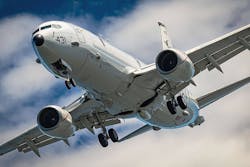BAE Systems to build electronic warfare (EW) pod to help defend P-8A aircraft from radar-guided missiles
PATUXENT RIVER NAS, Md. – U.S. Navy airborne electronic warfare (EW) experts needed an electronic pod to help protect large aircraft such as the P-8A Poseidon maritime patrol and surveillance aircraft from radar-guided missiles and electronic jamming. They found their solution from BAE Systems.
Officials of the Naval Air Systems Command at Patuxent River Naval Air Station, Md., announced a $95.3 million order in late March to the BAE Systems Electronic Systems segment in Nashua, N.H., for low-rate initial production of the Advanced Survivability Pod for the P-8A aircraft.
The pod helps P-8A crews detect and counter electromagnetic spectrum threats such as radar-guided missiles and EW jamming at extended ranges, BAE officials say. It helps the P-8A counter enemy guided missiles, sensors, radar, and surveillance systems.
The BAE Systems Advanced Survivability Pod is for so-called high-value airborne assets such as the P-8A; the C-130 and C-17 cargo jets; and KC-135 and KC-46 aerial tankers, and to help these aircraft operate closely to enemy airspace.
The portable EW pod delivers multi-spectral threat detection, countermeasures, and route planning to improve aircraft survivability; sensor fusion for situational awareness; long-range threat warning; RF countermeasures; portability; dynamic route planning and tactics; and readiness for emerging threats.
The Advanced Survivability Pod mounts to the P-8A pylon to create a protective shield around the aircraft to detect threats from above and below.
The pylon pod includes high-performance RF antennas; small-form-factor RF jammer; high-power RF amplifier; fiber-optic towed decoy; and infrared threat-detection sensors. Its open-architecture design is compatible with future threat-detection and decoy countermeasures, and can host third-party EW techniques.
On this order BAE Systems will do the work in Nashua, N.H.; Austin, Texas; and Patuxent River Naval Air Station, Md., and should be finished by January 2030. For more information contact BAE Systems Electronic Systems online at www.baesystems.com/en-us/our-company/inc-businesses/electronic-systems, or Naval Air Systems Command at www.navair.navy.mil.
About the Author
John Keller
Editor-in-Chief
John Keller is the Editor-in-Chief, Military & Aerospace Electronics Magazine--provides extensive coverage and analysis of enabling electronics and optoelectronic technologies in military, space and commercial aviation applications. John has been a member of the Military & Aerospace Electronics staff since 1989 and chief editor since 1995.
